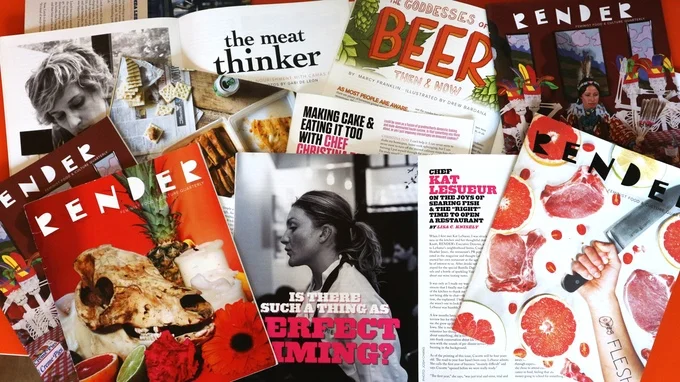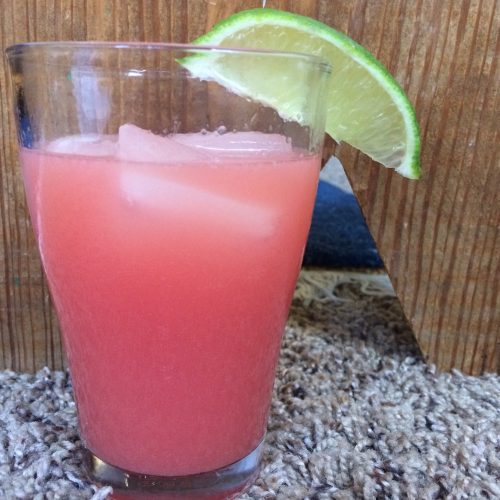A Blood Orange-tinged Moscow Mule (recipe below).
In each monthly installment of Bender, Caroline Ferguson will explore the social, cultural, and historical context of a single cocktail or boozy beverage. From settling which country lays claim to Pisco, to exploring the Carthusian Monks’ Chartreuse caves, Caroline will try to track down all the places your drink has been before it gets in your glass—always ending with a recipe of her own creation. Pull up a chair and a glass.
A few years back, Mad Men’s popularity brought a number of old-school cocktails back into the limelight. Believe it or not, it wasn’t always the norm for twentysomethings to chase their PBRs with vodka gimlets and old-fashioneds. No drink benefited more from the trend than the Moscow mule.
A recipe published on Chow back in 2007 – the year Mad Men debuted, incidentally – put the cocktail on the “endangered species list,” “rarely seen outside of vintage ads in old issues of Playboy magazine.”
As anyone who’s been to a bar in the last five years knows, that’s not exactly the case anymore. Moscow mules have exploded, encouraged by canny bartenders who realized that they could charge much more than the simple drink was worth. In fact, the drink has become so popular that it’s started to incur backlash, often topping lists of the most overrated cocktails: “Everyone is using it as the cocktail that placates the vodka drinkers,” L.A. bartender Eric Alperin told Thrillist.
As chance would have it, that’s pretty much exactly what the Moscow mule was designed to be. Yes, designed. Turns out that they weren’t dreamt up by hardy Russian grandmothers looking to take the edge off of long Moscow winters, as I’d so dearly hoped. Quite the opposite: the Moscow mule was actually a byproduct of the de-Russification of the Smirnoff brand, which the Soviet expat Rudolph Kunett sold to American booze tycoon John Martin back in 1939.
Martin found his new acquisition difficult to market to a stateside audience. Turns out that his friend Jack Morgan, who owned the Cock’n’Bull pub on the Sunset Strip, was in a similar boat: his house ginger beer just wasn’t selling. According to legend, Martin and Morgan invented the drink together in a fit of tipsy inspiration on one fateful night at the Cock’n’Bull in 1941, mixing two parts ginger beer with one part vodka, adding a squeeze of lime and dubbing it the Moscow mule. (Head bartender Wes Price disputed the story, arguing that he’d simply invented the cocktail himself to unload the two unpopular products.)
Whoever invented the thing, the next step was clear: they’d have to market the hell out of it. This is where the iconic copper mug comes in. Reports are a bit uncertain here, but most agree that a third party associated with Martin and Morgan – possibly Morgan’s girlfriend – had a surplus of mugs on hand after inheriting a struggling copper company. The two placed an order for mugs engraved with the names of celebrities who patronized the Cock’n’Bull, and Martin was said to have gone from bar to bar promoting the drink. The smoke-and-mirrors marketing worked wonders, and an all-out craze ensued. (To this day, the trendy copper mugs are notoriously hard to hold on to—one of my favorite bars in Seattle charges “$35 extra if the mug accidentally falls into your handbag.”)
The mule enjoyed more or less unencumbered popularity until the ‘50s, when the cocktail came under fire for its assumed Russian ties. Smirnoff testified that their vodka was American-made and had no communist ties, but boycotts of the drink had already tarnished its carefully crafted image. The drink fell into obscurity during the ‘60s, never to be heard from again—or at least until Mad Men premiered. Thus began the era of the oft-derided ten dollar artisan mule.
The Moscow mule’s comeback may have unfolded behind the bar, but I find that it makes for an ideal at-home cocktail. It requires no obscure liqueurs or bitters, no complex garnishes or shakers, or other nonsense. Furthermore, the mixing ratio couldn’t be simpler, and if you spring for a decent ginger beer it’ll cover up a not-so-great vodka pretty effectively (don’t tell the purists I said that).
My version of the classic mule has an appropriately spooky name that would be welcome by the pitcher at any Halloween party. I’m lucky enough to live in Seattle, where Moscow mules mean one thing and one thing only: Rachel’s ginger beer. The Pike Place Market ginger beer shop's sublime brew is a cult favorite among Seattle bartenders, and I’ve used their blood orange flavor here. If you don’t feel like paying nearly $80 to have a gallon shipped to you, just mix San Pellegrino’s Aranciata Rossa (a blood orange soda) with your favorite ginger beer to taste.
I realize that this may be the least autumnal-looking cocktail of all time, but trust me—the taste is all crisp citrus and ginger, perfect for October.
Blood Orange Moscow Mule
1 part vodka
2 parts blood orange ginger beer (or a mixture of ginger beer and blood orange soda)
Lime wedge
Pour the vodka over ice into a copper mug or highball glass. Squeeze the lime over the vodka and ice, then place in the glass. Top with ginger beer and stir. Garnish with another lime wedge if desired.





















